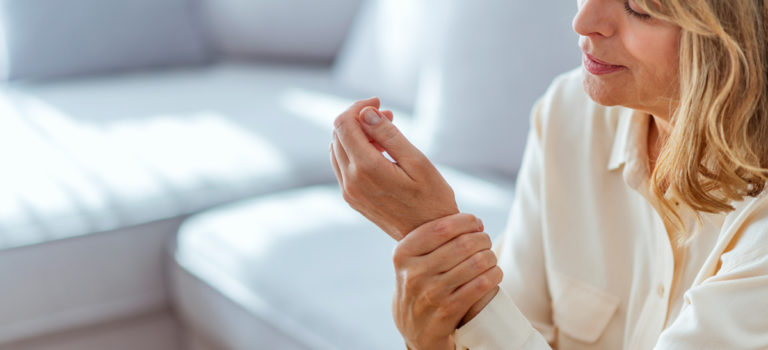Osteoporosis causes bone to become weak and brittle – so brittle that a fall or even mild stresses such as bending over or coughing can cause a fracture. These fractures most often occur in the hip, wrist or spine.
Because bone is living tissue, it means that it is constantly being broken down and replaced. Osteoporosis happens when the creation of new bone doesn’t keep up with the loss of old bone. While the disease affects men and women, white and Asian women, especially older, post-menopausal women, are at a higher risk.
Some of the key facts and statistics regarding Osteoporosis:
- One in three women over age 50 will experience osteoporotic fractures
- Women can lose up to 20% of bone mineral density in the 5 to 7 years post-menopause
- Women treated with hormone therapies for breast cancer are at risk to lose bone mineral density due to lower estrogen
The good news is that there are preventative treatments that anyone can use to prevent bone mineral loss – exercise and nutrition!
The exercise program must be diversified for best results. Walking alone is not enough, but is necessary. Strength training or body weight exercise combined with walking is most effective. Body weight squats, step-ups, resistance band rows and chest-presses are just a few examples that not only increase bone stimulation, but also improve overall strength and balance. In addition, short duration, long term use of whole body vibration has shown positive results in preventing bone density loss. The American College of Sports Medicine recommends 150 minutes of exercise weekly.
A bone protective diet must be rich in calcium and vitamin D, but should also include other important nutrients like Vitamins C and K, magnesium, and zinc. To ensure adequate intake of these nutrients, aim for 5 or more servings of fruits and vegetables per day. Limiting sodium can prevent calcium loss so limit or avoid foods high in sodium like processed meats, fast food, salty snack foods (i.e. chips, popcorn), pickled vegetables, and most canned goods.
Sample Meal Plan for Osteoporosis
| Day 1 | Day 2 | Day 3 | |
| Breakfast | Oatmeal topped with chia seeds, blueberries
Low-fat milk or Calcium & Vitamin D-fortified plant-based milk |
Scrambled eggs with red bell pepper strips and shredded cheese wrapped in corn tortilla
Decaf tea |
Low-fat plain yogurt topped with walnuts, strawberries, chia seeds and ground cinnamon |
| Lunch | Whole wheat pita with grilled chicken, guacamole
Tossed green salad with olive oil & vinegar dressing |
Spinach salad with carrots, tomatoes, boiled egg, chickpeas, avocado, and yogurt-based dressing
Whole grain crackers |
Vegetable and white bean soup
Whole grain crackers with low-fat cheese |
| Dinner | Salmon
Cooked spinach Brown rice |
Chicken breast
Okra Corn
|
Pork tenderloin
Steamed broccoli Baked sweet potato
|
| Snack | Cottage cheese with Orange wedges | Almonds, dried figs or plums | Hummus with cucumber slices |
Woman’s osteo-clinic incorporates a multidisciplinary team of physical therapy, occupational therapy, medical exercise, fitness, and nutrition. Our testing focuses on balance, posture, functional strength, endurance to formulate a program for each individual. Participants engage in whole body vibration therapy during visits with physical therapists and exercise physiologists.
The bottom line is that exercise and nutrition help most chronic conditions, osteoporosis included.

